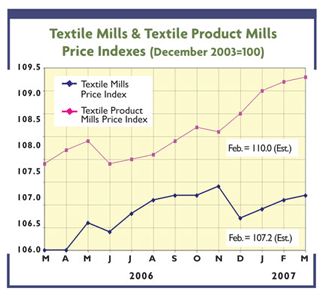T
his is a month of transition for Yarn Market as
Textile World
says goodbye and good luck to long-time contributor Alfred Dockery. Alfred’s
contributions to these pages have been significant over the years, and he will be sorely missed by
both the staff and readers of Textile World.
For the sake of continuity, it pleases me to be asked to rejoin
TW
and be the shepherd of this column. I will endeavor to capably fill Alfred’s rather large
shoes and maintain the standards set by Al and his predecessors James Lemons, Clarence Rogers and
Karl Rudy.
As
TW
readers know all too well, the past few decades have seen market conditions and
regulations emerge that have put US textiles at a competitive disadvantage with much of the rest of
the world. The focus today is on innovation and specialty products — on finding that particular
niche that a company can fill better, faster, and more efficiently than anyone else.
In the future, Yarn Market will begin to look at some of the new things spinners are doing
not only to remain competitive in a difficult world market, but also to pave the way for new
avenues of growth, product development and customer acquisition. In addition, of course, this
column will continue to report on things — such as news and rumor within the traditional spinning
industry, yarn prices and trends, operating conditions and scheduling—- that have made this one of
TW
’s most popular columns.
As for new trends sweeping the industry, one of note is the current focus by retailers on “
value added.” According to one noted ring spinner, apparel retailers are constantly searching for
that value-added attachment. “The more popular approaches have been performance fabrics, and even
more recently, the ‘green concept.’” “Green,” of course, is the consumer craze today and refers to
yarn manufactured from organic cotton and recyclable fibers.
Interestingly enough, this green manufacturing is not anything new to the industry. As is
often the case, product development sometimes runs well ahead of consumer preferences. Almost 15
years ago, Martin Color-Fi introduced a product called NatureTex®, a line of post-consumer recycled
polypropylene fibers targeted for automotive, marine and recreational vehicle carpet. At the same
time, Wellman Industries had a similar product on the market.
Today, however, a more environmentally conscious consumer not only is more receptive to these
types of innovations, but also is demanding them.
And while the manufacturing of organic products may provide an opportunity for some, for
others, it’s like chasing the rainbow and looking for the pot of gold at the end.
“Manufacturing organic products may be great for a company like Parkdale that has the
resources to do it,” said one specialty ring spinner of heavy-count cotton. “But for a small
company like us, it may not be feasible. We’ve had a few inquiries from some of our customers, but
we’ve stayed away from it. We just can’t justify the cost. If you stay with US-certified organic,
which is what the customer wants, it can be very expensive.”
The same spinner points to studies recently released into the market that indicate a green
certification is more hype than benefit. “It’s not like the ’60s,” he said. “Cotton is no longer
the chemical-saturated commodity it used to be.”
Regardless of what value-added products are currently in demand, spinners are still not happy
with the state of the market so far this year. “I still sense a softness in the market,” said one
spinner. “When business is good, we run six days, eight hours a day. In normal business times, we
run five days, eight hours a day. Right now, we’re running just under a full five-day schedule. We
haven’t seen the sixth day in quite a while.”
Said another: “Our business has not reflected the demand that we expected, based upon the
same period last year. There have been brief periods during the first quarter that yielded positive
signs; however, there has been no sustained market enthusiasm.”
As for what the future holds, it’s a mixed bag. “Right now, I have to say I see a few more
negatives than positives in the market,” said the specialty ring spinner. “I’ve been hitting the
road — down to Mexico, for example — trying to make some things happen. But I haven’t found
anything that makes me smile. My biggest problem is that I have a dwindling customer base. The
companies I have traditionally sold to — they’re almost all gone.”
Another spinning executive, however, expressed guarded optimism: “Based upon a high level of
development and samples, as well as customer expectations, we remain optimistic that the delayed
business development this quarter will offer opportunity for improved order backlog into the third
quarter.”
As far as prices are concerned, things seem to be pretty much status quo at the moment. “
Everything is pretty much stable right now,” said one Georgia spinner. “Our costs are pretty much
stable. Our suppliers are pretty stable. Because of market conditions, we don’t give raises
anymore. The only thing that is really hurting us is the cost of power — it’s gone sky high.”
With the market still somewhat flat, it’s safe to say the next quarter will be one in which
many spinners will continue to mark time and position themselves for what they hope will be
increased business activity in the last half of the year. Regardless of market conditions, as
evidenced by the current clamoring by retailers for organic products, there are still opportunities
out there for the aggressive and innovative spinner to make some noise.
April 10, 2007





